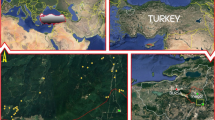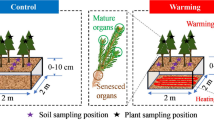Abstract
Species composition and photosynthetic characteristics of dominant species of ungrazed plot (UG), overgrazed plot (OG), and restored grazed plot (RG) were determined in the Xilin River Basin, Inner Mongolia, China. Both heavily grazing and restoration significantly affected the composition of different species and life forms. Leymus chinensis, Stipa grandis, and Cleistogenes polyphylla, three dominant perennial grasses in UG plot, contributed 58.9 % aboveground biomass to that of whole community, and showed higher net photosynthetic rate (P N), transpiration rate (E), and intrinsic water-use efficiency (WUE). In OG plot, relative biomass of L. chinensis and S. grandis significantly decreased, while relative biomass of three shrubs/sub-shrubs, Caragana microphylla, Artemisia frigida, and Kochia prostrata, obviously increased. Heavy grazing significantly decreased P N, E, and WUE of L. chinensis and S. grandis, while shrubs/sub-shrubs showed significantly higher photosynthetic activity and WUE than the grasses. After 18-year restoration, photosynthetic activities of L. chinensis and S. grandis were significantly higher than those in the OG plot. The proportion of L. chinensis, S. grandis, and C. microphylla significantly increased, and relative biomass of C. polyphylla, A. frigida, and K. prostrata markedly declined in RG plot. We found close relationships between physiological properties of species and their competitive advantage in different land use types. Higher photosynthetic capability means more contribution to total biomass. The variations in physiological characteristics of plants could partly explain the changes in species composition during degrading and restoring processes of Inner Mongolia typical steppes.
Similar content being viewed by others
References
Belsky, A.J.: Does herbivory benefit plants? A review of the evidence. — Amer. Naturalist 127: 870–892, 1986.
Belsky, A.J., Blumenthal, D.M.: Effects of livestock grazing on stand dynamics and soils in upland forests of the interior west. — Conserv. Biol. 11: 315–327, 1997.
Chen, Z.Z.: [Topography and climate of Xilin River Basin.] — In: Inner Mongolia Grassland Ecosystem Research Station, the Chinese Academy of Sciences (ed.): Research on Grassland Ecosystem. No. 3. Pp. 13–22. Science Press, Beijing 1988. [In Chin.]
Christensen, L., Coughenour, M.B., Ellis, J.E., Chen, Z.Z.: Vulnerability of the Asian typical steppe to grazing and climate change. — Climate Change 63: 351–368, 2004.
Damhoureyeh, S.A., Hartnett, D.C.: Effects of bison and cattle on growth, reproduction, and abundances of five tallgrass prairie forbs. — Amer. J. Bot. 84: 1719–1728, 1997.
Fahnestock, J.T., Detling, J.K.: The influence of herbivory on plant cover and species composition in the Pryor Mountain Wild Horse Range, USA. — Plant Ecol. 144: 145–157, 1999.
Fahnestock, J.T., Knapp, A.K.: Plant responses to selective grazing by bison: interactions between light, herbivory and water stress. — Vegetatio 115: 123–131, 1994.
Fernandez-Gimenez, M., Allen-Diaz, B.: Vegetation change along gradients from water sources in three grazed Mongolian ecosystems. — Plant Ecol. 157: 101–118, 2001.
Hickman, K.R., Hartnett, D.C.: Effects of grazing intensity on growth, reproduction, and abundance of three palatable forbs in Kansas tallgrass prairie. — Plant Ecol. 159: 23–33, 2002.
Katoh, K., Takeuchi, K., Jiang, D., Nan, Y., Kou, Z.: Vegetation restoration by seasonal exclosure in the Kerqin Sandy Land, Inner Mongolia. — Plant Ecol. 139: 133–144, 1998.
Lavorel, S., McIntyre, S., Grigulis, K.: Plant response to disturbance in a Mediterranean grassland: how many functional groups? — J. Veget. Sci. 10: 661–672, 1999.
Li, Y.H.: Impact of grazing on Aneurolepidium chinense steppe and Stipa grandis steppe. — Acta oecol./Oecol. appl. 10: 31–46, 1989.
Li, Y.H.: [Grazing dynamics of the species diversity in Aneurolepidium chinense steppe and Stipa grandis steppe.] — Acta bot. sin. 35: 877–884, 1993. [In Chin.]
Liang, C., Michalk, D.L., Millar, G.D.: The ecology and growth patterns of Cleistogenes species degraded grasslands of eastern Inner Mongolia, China. — J. appl. Ecol. 39: 584–594, 2002.
McNaughton, S.J.: Compensatory plant growth as a response to herbivory. — Oikos 40: 329–336, 1983.
McNaughton, S.J.: Ecology of a grazing ecosystem: the Serengeti. — Ecol. Monogr. 55: 259–294, 1985.
Wang, J.W., Cai, C.: [Studies on genesis, types and characteristics of the soils of the Xilin River Basin.] — In: Inner Mongolia Grassland Ecosystem Research Station, the Chinese Academy of Sciences (ed.): Research on Grassland Ecosystem. No. 3. Pp. 23–83. Science Press, Beijing 1988. [In Chin.]
Wang, S.P., Li, Y.H.: [Degradation mechanism of typical grassland in Inner Mongolia.] — Chin. J. appl. Ecol. 10: 437–441, 1999. [In Chin.]
Wang, S.P., Li, Y.H., Wang, Y.F., Chen, Z.Z.: [Influence of different stocking rates on plant diversity of Artemisia frigida community in Inner Mongolia steppe.] — Acta bot. sin. 43: 89–96, 2001. [In Chin.]
Wang, W., Liu, Z.L., Hao, D.Y., Liang, C.Z.: [Research on the restoring succession of the degenerated grassland in Inner Mongolia I. Basic characteristics and driving force for restoration of the degenerated grassland.] — Acta phytoecol. sin. 20: 449–459, 1996a. [In Chin.]
Wang, W., Liu, Z.L., Hao, D.Y., Liang, C.Z.: [Research on the restoring succession of the degenerated grassland in Inner Mongolia II. Analysis of the restoring processes.] — Acta phytoecol. sin. 20: 460–471, 1996b. [In Chin.]
Wu, J.G., Loucks, O.: Xilingele. — In: Committee on Scholarly Communication with the People's Republic of China, National Research Council (ed.): Grasslands and Grassland Sciences in Northern China. Pp. 67–84. National Academies Press, Washington 1992.
Zhou, G., Wang, Y., Wang, S.: Responses of grassland ecosystems to precipitation and land use along the Northeast China Transect. — J. Veget. Sci. 13: 361–368, 2002.
Author information
Authors and Affiliations
Corresponding author
Rights and permissions
About this article
Cite this article
Chen, S.P., Bai, Y.F., Lin, G.H. et al. Effects of grazing on photosynthetic characteristics of major steppe species in the Xilin River Basin, Inner Mongolia, China. Photosynthetica 43, 559–565 (2005). https://doi.org/10.1007/s11099-005-0088-9
Received:
Accepted:
Issue Date:
DOI: https://doi.org/10.1007/s11099-005-0088-9




